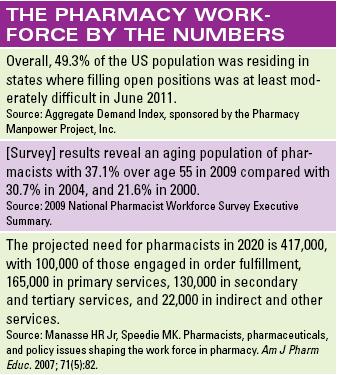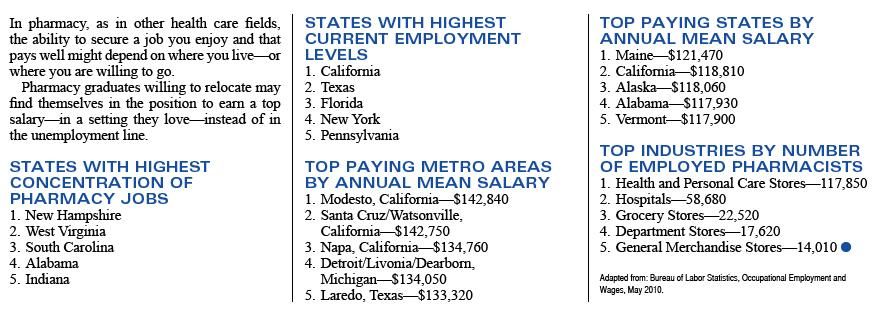Publication
Article
Pharmacy Careers
Pharmacy Workforce Trends
Author(s):
Pharmacy job market information is critical as students prepare themselves for the changing demands of today's workplace.
Pharmacy job market information is critical as students prepare themselves for the changing demands of today's workplace.
Pharmacy is a field in flux. The basic responsibilities and public perception of the pharmacist are evolving. At the same time, the pharmacy job market is undergoing important changes in supply and demand.
Pharmacy job market information can be confusing. Some sources say that a pharmacist shortage still exists, whereas others warn that the recent expansion and opening of pharmacy schools will lead to a large surplus in the near future.
A recent discussion paper by the American Pharmacists Association (APhA) and the American Society of Health-System Pharmacists (ASHP), entitled “Concerns about the Accelerating Expansion of Pharmacy Education: Time for Reconsideration,” sheds some light on this important issue. These observations can give pharmacy graduates a new perspective on the job market they face.

Pharmacy Education Today
In 2001, the Pharmacy Manpower Project—a nonprofit group that monitors data on the supply of and demand for pharmacists—suggested that the United States would be short 157,000 pharmacists by the year 2020.
Although there had been pharmacist shortages in the past, the aging of the US population and the resulting need for medication experts made a potential lack of qualified pharmacists particularly critical. The decline in the number of primary care physicians means that pharmacists, as the most accessible health care providers, are now needed more than ever.
The pharmacy education community responded by opening new pharmacy schools and expanding existing programs. The APhA-ASHP paper notes that as of July 2010, 115 schools of pharmacy were open with full accreditation or candidate status, with 5 more schools in the precandidate stage of accreditation. This is a stark contrast to just decades ago—before 1987, there were only 72 US pharmacy schools.
The Evolution of Pharmacy Practice
The APhA-ASHP discussion paper also describes a critical change in the role of pharmacists. It states that pharmacists are increasingly overseeing the dispensing of medications, rather than personally “doing” the work of medication distribution.
In the wake of this change, pharmacists are also assuming more patient care responsibilities, including medication therapy management, patient counseling, health screenings, and immunizations. In response, the authors write, “New pharmacy graduates will need to perform both the traditional work of the profession and the work that is linked to the future.”
Today’s pharmacists rely on technology and support staff to allow them to assume time-consuming patient care responsibilities. Without automation and the support of pharmacy technicians, many pharmacists would find it difficult to embrace this change in the profession.
Feeling the Impact of Expansion
The APhA and ASHP warn that the rapid expansion of pharmacy education programs will cause growing pains that, if not addressed, could negatively impact pharmacy students and the profession as a whole.
They raise concerns that the increase in pharmacy programs is causing a shortage of quality faculty to teach and mentor the current crop of pharmacy students. In the 2008-2009 academic year, a survey revealed that there were 396 vacant or lost faculty positions at schools of pharmacy. Nearly half of these positions remained unfilled due to a lack of qualified candidates.
The increase in pharmacy school enrollments also means that there are often not enough experiential rotations available to meet the demand. In a survey of 43 experiential directors at pharmacy schools, 81% of respondents said that it is “extremely difficult” or “somewhat difficult” to find quality hospital and health-systems placements for their students. For community pharmacy placements, 51% of directors said finding a placement was “extremely difficult” or “somewhat difficult.”
The American Association of Colleges of Pharmacy, APhA, and ASHP are all taking steps to provide resources for finding experiential learning placements and recruit quality preceptors for students. More information can be found on the associations’ Web sites (see page 25 for more information).
Filling in the Gaps
What can current pharmacy students do to prepare themselves for the changing demands of the modern workplace? Pharmacy students, especially those who are interested in the health-systems practice setting, might consider postgraduate residency training. Residencies can be a valuable tool to develop one’s skills and specialize in specific areas of interest.
Patient care experience is also key. Pharmacy students can hone their patient care skills outside the classroom by volunteering their time in the community. The special skills of pharmacy students are needed at health fairs and screenings, where patient counseling and disease state management is the central focus.
Pharmacy students might also consider more nontraditional career choices, such as specialty pharmacy, managed care, and long-term care positions.
Although the competition might be a bit stiffer, the increase in pharmacy education programs and enrollment does not mean that good positions will be impossible to find. To supplement their education, pharmacy students should seek opportunities to hone their current knowledge and develop new skills that will set them apart from other pharmacy job seekers.
Information for Success








